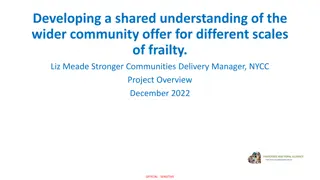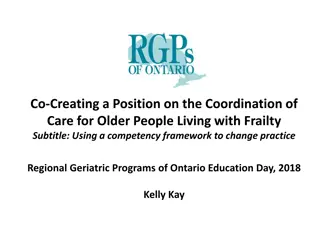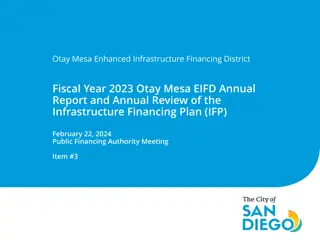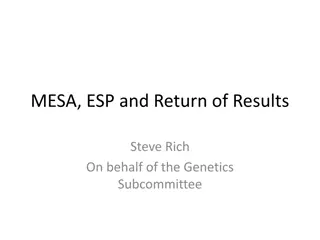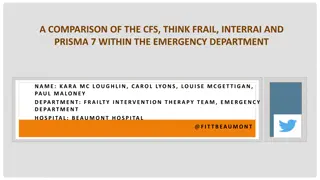
Novel Frailty Biomarkers in Older Adults
Explore the pathogenesis of physical frailty and sarcopenia in humans and mice, focusing on developing and testing a unique biomarker signature for early detection and intervention. Projects include assessing biomarker validity and associations with functional capacity in older adults, using imaging techniques and serum biomarkers. Engage in concurrent and predictive validity studies, shedding light on the role of biomarkers in frailty and sarcopenia progression.
Download Presentation

Please find below an Image/Link to download the presentation.
The content on the website is provided AS IS for your information and personal use only. It may not be sold, licensed, or shared on other websites without obtaining consent from the author. If you encounter any issues during the download, it is possible that the publisher has removed the file from their server.
You are allowed to download the files provided on this website for personal or commercial use, subject to the condition that they are used lawfully. All files are the property of their respective owners.
The content on the website is provided AS IS for your information and personal use only. It may not be sold, licensed, or shared on other websites without obtaining consent from the author.
E N D
Presentation Transcript
MESA Frailty Matthew Baldwin, MD, MS Herbert Irving Assistant Professor of Medicine Columbia University
NIA U19 Collaborative multicomponent award May 25, 2018 submission Four R01-equivalent projects $2M direct costs/year Data Science and Administrative Core 5-year duration Full application by invitation Based on letter of intent with project aims
Pathogenesis of Physical Frailty & Sarcopenia in Mice & Humans Develop and test a novel biomarker signature Unique to frailty Allows early detection Amenable to intervention Biomarkers Serum Osteocalcin Mitochondrial function Serum FGF-21 and GDF-15 Mitochondrial health index in PBMCs Mitochondrial function at the neuromuscular junction Substantia Nigra (SN) Dopamine
MESA Frailty Project 4, AIM 1: Assess the concurrent and predictive validity of novel biomarkers of frailty in older adults. Project 3, Aim 3: Assess the association between substantia nigra dopamine level and functional capacity in older adults.
Novel Frailty Biomarkers Concurrent Validity Study Design Cross-sectional, Exam 7 Participants Columbia/UCLA Exposure Variables SN Dopamine levels (FDOPA PET CT brain), subsample by frailty status Mitochondrial Health Index in PBMCs Serum FGF-21 and GDF-15 Serum Osteocalcin Outcome Variables Frailty: Short Physical Performance Battery (SPPB) Sarcopenia: FNIH Sarcopenia (DXA lean mass & grip)
Novel Frailty Biomarkers Predictive Validity (of Frailty) Study Design Retrospective cohort study Participants Columbia/UCLA Exam 7 participants Also with clinic visit for Exam 2 Exclude home visits, minimize sampling those with prevalent frailty Exposure Variables Serum Osteocalcin (Exam 2) Mitochondrial function (Exam 2) Serum GDF-15 and FGF-21 Outcome Variables Frailty: SPPB (Exam 7) Sarcopenia: FNIH sarcopenia (Exam 7) Change in physical activity survey scores (Exams 2, 3, 5, 6, 7)
Novel Frailty Biomarkers Predictive Validity (of Clinical Outcomes) Study Design Prospective cohort study Participants Columbia/UCLA Exam 7 participants Exposure Variables SN Dopamine levels (FDOPA PET CT) Mitochondrial Health Index in PBMCs Serum FGF-21 and GDF-15 Serum Osteocalcin Outcome Variables (annual telephone follow-up x 3 years) Basic ADL disability Hospitalization Institutionalization Mortality
Substantia Nigra Dopamine & Functional Capacity Study Design Cross Sectional, Exam 7 Participants Participants with FDOPA PET CT Exposure Variable SN Dopamine level Outcome Variables 6MWT Home actigraphy Abdominal muscle mass on L4 L5 Abdominal CT image* Locomotion (psoas) Stabilization (rectus abdominus, obliques, paraspinal) *Remigio-Baker RA, Allison MA et al. BMC Psychiatry, 2015






